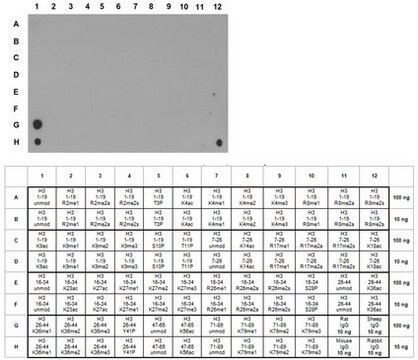04-835
Anti-dimethyl-Histone H3 (Lys79) Antibody, clone NL59, rabbit monoclonal
culture supernatant, clone NL59, Upstate®
Sinonimo/i:
H3K79me2, Histone H3 (di methyl K79)
About This Item
Prodotti consigliati
Origine biologica
rabbit
Livello qualitativo
Forma dell’anticorpo
culture supernatant
Tipo di anticorpo
primary antibodies
Clone
NL59, monoclonal
Reattività contro le specie
vertebrates, human
Produttore/marchio commerciale
Upstate®
tecniche
ChIP: suitable (ChIP-seq)
dot blot: suitable
multiplexing: suitable
western blot: suitable
Isotipo
IgG
N° accesso NCBI
Condizioni di spedizione
dry ice
modifica post-traduzionali bersaglio
dimethylation (Lys79)
Informazioni sul gene
human ... H3F3B(3021)
Descrizione generale
Specificità
Immunogeno
Applicazioni
Sonicated chromatin prepared from HeLa cells (1 X 10E6 cell equivalents per IP) were subjected to chromatin immunoprecipitation using either 4 µL of Negative Control Supernatant, or 4 µL of Anti-dimethyl-Histone H3 (Lys79) and the Magna ChIP A Kit (Cat. # 17-610). Successful immunoprecipitation of dimethyl-Histone H3 (Lys79) associated DNA fragments was verified by qPCR using Control Primers
Please refer to the EZ-Magna ChIP A (Cat. # 17-408) or EZ-ChIP (Cat. # 17-371) protocol for experimental details.
Chromatin Immunoprecipitation: A representative lot of this antibody has been shown by an independent laboratory to work in ChIP.
ChIP-Seq Analysis:
A representative lot of this antibody was used by an independent laboratory for ChIP-Seq. See Egelhofer, T.A., et al. (2011). See Easwaran, H., et al. (2012).See Suzuki, H., et al. (2011).
Dot Blotting: Specificity of a representative lot confirmed by the ability of a 1:2500 dilution of the antibody to recognize peptides corresponding to regions of histone H3 with various modifications
Dot Blot Analysis: Absurance Histone H3 Antibody Specificity Array (Cat. No. 16-667) and Absurance Histone H2A, H2B, H4 Antibody Specificity Array (Cat. No. 16-665), which contain histone peptides with various modifications were probed with Cat. No 04-835-S, Anti-dimethyl Histone H3 (Lys79) Antibody, clone NL59 (1:500 dilution). Proteins were visualized using a Donkey anti-rabbit IgG conjugated to HRP and a chemiluminescence detection system.
Epigenetics & Nuclear Function
Histones
Qualità
Descrizione del bersaglio
Linkage
Stato fisico
Stoccaggio e stabilità
Handling Recommendations: Upon receipt, and prior to removing the cap, centrifuge the vial and gently mix the solution. Aliquot into microcentrifuge tubes and store at -20°C. Avoid repeated freeze/thaw cycles, which may damage IgG and affect product performance.
Note legali
Esclusione di responsabilità
Not finding the right product?
Try our Motore di ricerca dei prodotti.
Codice della classe di stoccaggio
10 - Combustible liquids
Classe di pericolosità dell'acqua (WGK)
WGK 2
Certificati d'analisi (COA)
Cerca il Certificati d'analisi (COA) digitando il numero di lotto/batch corrispondente. I numeri di lotto o di batch sono stampati sull'etichetta dei prodotti dopo la parola ‘Lotto’ o ‘Batch’.
Possiedi già questo prodotto?
I documenti relativi ai prodotti acquistati recentemente sono disponibili nell’Archivio dei documenti.
Il team dei nostri ricercatori vanta grande esperienza in tutte le aree della ricerca quali Life Science, scienza dei materiali, sintesi chimica, cromatografia, discipline analitiche, ecc..
Contatta l'Assistenza Tecnica.








